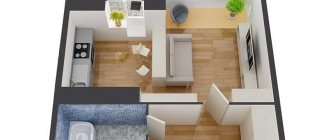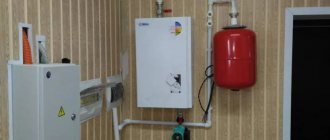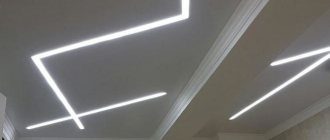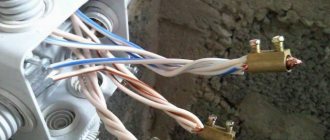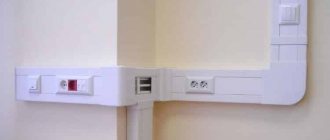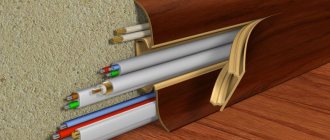assets/from_origin/upload/resize_cache/iblock/aaa/600_450_2/aaa7386d9d122400be3f7575aee37492.jpg From this article you will learn:
- When and why to carry out electrical repairs in an apartment
- What are the key rules to follow when repairing electrical equipment in an apartment?
- What is the importance of planning when repairing electrical equipment in an apartment?
- What tools are needed for electrical repairs in an apartment?
- How to choose the right cable
- How to dismantle old electrical equipment
- What types of cable laying are there?
- How to do electrical repairs in an apartment with your own hands
- What factors determine the price of electrical repairs in an apartment?
Cleanliness and comfort in an apartment are, of course, good, but the safety of living in it is much more important. To a greater extent, this concerns the rules for operating electrical networks, which need to be given special attention. For any modern home, be it a separate house or apartment, there are certain regulations and standards for the supply of electricity that must be observed. Knowing all the features of choosing and laying wires, following safety rules, electrical repairs in an apartment will no longer look like such a difficult task. In this article we will try to help you with its solution.
When and why to carry out electrical repairs in an apartment
Due to the high cost of residential real estate in our country, the secondary housing market is highly developed. The number of people wishing to buy used apartments not only does not decrease, but continues to grow. As a rule, after purchasing such an apartment, new residents immediately think about electrical repairs.
For older houses in Moscow, repair of electrical wiring is especially important, since the previous electrics during the construction of such houses were designed for other loads. For example, if previously the energy consumption of one apartment did not exceed 2 kW, now it can reach up to 10 kW due to the abundance of powerful equipment in apartments (microwave ovens, vacuum cleaners, washing machines, etc.). For safe simultaneous operation of all devices, sometimes it is necessary to change the meter to a new one, designed for a current of 50 A or more.
When the rated load on the network is systematically exceeded when using additional or more energy-intensive household appliances, the old electrical wiring suffers and eventually requires repair - the insulation is destroyed, the aluminum conductors lose their plastic properties. Moreover, the very location of the electrical damage is often very difficult to find, and sometimes it even requires opening the wall in the apartment.
Worn wires become unpredictable, unreliable, and therefore dangerous. Only its complete replacement will help ensure the safety of the energy network in the apartment. All electrical equipment is subject to repair: wiring with connection points, all protective devices, and switches. When replacing all elements with new ones during repairs, it is necessary to reserve a maximum load so that in the future it will be possible to use more powerful household appliances.
Here are the main problems that can arise in an apartment even with new electrical wiring:
- As a result of damage to the insulation at the bend in the wire, a short circuit may occur.
- Excessive heat at the junction of several wires may indicate poor contact. As a result, due to the high temperature, the contact gradually melts, the insulation is destroyed, and the conductor cores burn out.
- During renovations in an apartment (for example, when drilling walls), there is a danger of damaging the wire with a tool, since electrical wiring is often laid inside the walls.
The following rules will help you carry out a complete electrical repair in your apartment.
How to carry out major repairs of electrical wiring in a microdistrict
The appeal raises the issue of canceling the court decision and making a new decision in the case. The arguments of the complaint boil down to a violation of the law by the court. Having checked the legality and validity of the decision, based on the arguments set out in the complaint, having heard the objections to the complaint of plaintiffs Kh., B.R., their representative B.G., having examined the case materials, the judicial panel comes to the following. In deciding to partially satisfy the claims of Kh. and B.R., the court came to the conclusion that OJSC “Managing Organization of Apartment Buildings of the Dzerzhinsky District” had improperly fulfilled its obligations for the maintenance of the apartment building, and therefore imposed on the defendant the obligation to carry out repairs in relation to common property of an apartment building. The panel of judges agrees with this conclusion in terms of imposing the responsibility on the management company to carry out routine repairs, and considers it correct in this part, based on the materials of the case and the law - Art. 29 of the Law of the Russian Federation “On the Protection of Consumer Rights”, Art. Art. 154, 158 Housing Code of the Russian Federation.
As follows from the case materials, the debt owed by plaintiffs Kh. and B.R. before OJSC "Manager of the Dzerzhinsky District" there was no housing maintenance and repair position. Under such circumstances, assigning the management company the responsibility to carry out routine repairs of the common property of the house is justified and complies with the terms of the obligations assumed by the Company under the house management agreement.
Planning for electrical repairs in an apartment
Before starting work on electrical repairs in the apartment, you need to draw a wiring plan. This is an important stage, since the final result, and therefore the safety in the apartment, depends on the correct design. For this work, you will need minimal knowledge in electrical engineering and an understanding of what current is. During the planning process, you will have to calculate the loads and subsequently transfer it to the drawing.
The plan must be drawn up, adhering to the standard designations of all elements in the apartment - sockets, switches, lighting points, and so on. The diagram in electrical repair is useful for the correct laying of power cables with a given load. The plan should also show the proposed locations of powerful household appliances, such as a microwave oven, electric kettle, washing machine, water heater. Powerful electrical appliances will require a cable with a larger cross-section than for lighting, a computer or a TV.
First you need to mark the electrical wiring points. There are three types of wiring: parallel, serial and mixed. It is more rational for an apartment to use the last option - it is both cheap and the most effective of all three. Having decided on the type, you need to draw up a plan of connection points.
For example, the plan could be like this:
- lighting in rooms, hallways and kitchens;
- lighting in the bathroom;
- power outlets in all living rooms and in the hallway;
- power outlets in the kitchen;
- power supply to the electric stove (if any);
- a separate line for powering the electric heater - it is better to connect it directly to the panel.
There may be other wiring options in relation to the specific needs of apartment residents. But in all cases, when repairing electrical equipment, it is important to correctly calculate the loads and, taking them into account, group the planned connection points.
The formed plan must be approved by the competent authorities. Only according to the approved project can you begin installation and wiring of cables in the apartment.
Features of current renovation of an apartment building
This is stated in Article 154 of the RF Housing Code. The tariff for it is set by local governments, and the order of implementation is taken from two to five years and varies depending on the type of residential buildings, the condition of the materials of the main structures, their wear and tear and environmental conditions.
Current home repairs are a set of measures taken by responsible organizations within the framework of maintaining the housing stock to maintain its satisfactory condition and eliminate faults that interfere with the comfort and safety of citizens.
Necessary tools for electrical repairs in the apartment
To install electrics inside the apartment, you will need the appropriate tools and materials:
- a set of screwdrivers, electrical pliers or pliers;
- tools for removing insulation (nippers, special knives, strippers);
- screwdriver;
- multimeter;
- other measuring devices;
- drill and hammer drill with appropriate attachments for working with wood and concrete;
- soldering iron;
- cable of the required length and accessories supplied with it;
- set of terminal blocks;
- cotton rubberized electrical tape;
- plastic boxes for installing sockets;
- household flashlight;
- knife and spatula;
- gypsum putty.
How to choose the right cable
Choosing the right cable for electrical repairs in an apartment mainly comes down to determining the cross-section of the core. And it will depend on the power consumption, for which you need to sum up the power of all electrical appliances that will be used in the apartment. Moreover, 100 W should be added to the power of each device for reserve. To determine the current strength, the resulting total power must be divided by the network voltage (220 V). Usually the result is obtained in the range from 12 to 16 A. For such a current, a copper cable with a cross-section of 1.5 square meters is quite sufficient. mm.
If the current is higher than 16 A, you can use several cables of the same cross-section. To do this, the cable lines must be connected in parallel to the panel, providing each of them with a separate RCD. This solution will be cheaper and more reliable than using one cable of a larger cross-section when repairing electrical equipment. The copper cores of the cable have proven their practicality, so they should be given preference. Their characteristics are 1.5 times higher compared to aluminum ones.
Safety rules for electrical repairs in an apartment
- Before starting electrical repairs, it is necessary to turn off the power to the apartment.
- Under no circumstances should you work with a live cable.
- Soldering of wires must be done using special gloves.
- The wire should be cleared of burrs before it is placed in the tube.
Dismantling old electrical
Old wiring installed inside the wall is sometimes difficult to find visually. In this case, a special detector is used to determine the location of the cable.
Before dismantling the electrics, the apartment is de-energized with a switch in the distribution panel. The old cable is disconnected from the panel, then it is carried into the apartment for temporary power supply. Be sure to make sure that there is no voltage in the sockets of the apartment.
It’s easier to start dismantling electrical wiring from distribution boxes, and use old channels to lay new electrical wires. The new wire attaches to the old one inside the box, the old wire is then pulled out.
This method, however, is not suitable in all cases - for example, during electrical repairs with changes in the network layout, it is not suitable. If the old electrical network of the apartment is plastered inside the wall, you can either carefully open the grooves and replace the wire, or lay new channels parallel to the old ones.
How to check switches and sockets
To identify and fix the problem in this case, you will need an indicator screwdriver. With its help, it is easy to understand which wire is broken: “phase” or “zero”.
Indicator screwdriver
When inspecting the contacts in this way and the power supply is turned on, only one cable is energized in the sockets - in the off position. In switches this will be one (in the “off” position) or three wires - when it is on.
In any case, if the phase is present, this means that the zero is broken. Next, proceed to inspect the wiring and find the break point using a special device - a tester.
Tester
First, the electricity is turned off, and then notches are made on the cables at a certain interval - about a meter. By measuring the resistance between these points, you will see that the values will be approximately the same. Finding a big difference or almost complete absence of resistance will mean that you have found a break in the wiring in a certain area.
Now you will have to divide the cable into two more smaller sections and check them with a device. And so on until you establish the location of the break with high accuracy. Although it often happens that at a certain moment it is visible even with the naked eye.
When the search ends and the fault is eliminated, carefully insulate the exposed wires. That's it, the work is completed in a short time - which is what you wanted.
Cable laying types
You can already see that electrical repairs in an apartment are not an easy undertaking, and in this matter, confidence in your own correct actions is important.
The cable can be laid along the wall in three ways:
- On the wall without finishing before plastering;
- Inside the corrugated pipe;
- Inside is a plastic cable channel.
Everyone decides for himself which option is closer to him, provided that the location of the wiring can be easily determined in the future. Not knowing where a wire goes can cause it to be accidentally damaged during electrical repairs or even get electrocuted.
Hidden cable routing in partitions, floors and ceilings
If the room has a suspended ceiling made of plasterboard with a metal frame, then cable installation is greatly simplified. There is no need to groove the walls horizontally; all wires are hidden under drywall, brought to the walls and dropped vertically down to the required electrical points.
Laying wiring in a plasterboard ceiling
You can avoid drilling holes for junction boxes by placing them there. The only “but” is that in this case, plastic hatches will have to be inserted into the drywall opposite the boxes. By installing such a hatch, you can at any time gain access to electrical equipment located behind a partition or suspended ceiling. Lighting wires can be attached to the ceiling with clamps or hangers.
The pipes located below will later be under the floor
A good option is when the wiring is enclosed in plastic pipes attached to the ceiling using clips. This increases the fire safety of the plasterboard structure. If desired, the cable can be laid in the floor. Floors made of wood and gypsum fiber boards are well suited for this installation method.
| Hidden cable laying in a corrugated pipe: the depth of the groove must be such that there is at least 5 mm from the corrugation to the edge of the recess | The pipe is secured in the groove using ordinary nails or pressed by tightening screws (if the wall material allows) |
| Before covering the groove with plaster, it is necessary to moisten the groove with water and treat it with a primer | The groove is covered with plaster using a spatula |
| After applying the plaster, wait 10 minutes for it to dry. | Remove excess mixture with a spatula, leveling the surface |
In the first case, holes are cut or drilled in the joists, into which plastic pipes are inserted, and a cable passes inside them. In the second case, the pipes are simply laid on the floor, attached with staples to it and covered with expanded clay or other filler, on top of which the floor covering is laid.
Hidden installation option: wiring is embedded in a concrete screed
There is an option when the wiring is hidden in pipes and filled with cement mortar - placed under the screed. However, this is not recommended, especially if the layer of solution above the pipe is quite thin.
Attention! If the wiring is hidden in partitions, behind cladding or in the floor, then wires cannot be connected in these places. This can only be done in boxes, outside the boundaries of hidden wiring.
Do-it-yourself electrical repairs in an apartment: installation work
Grilling
Before starting work, you need to mark out places for laying cables, placing sockets, switches and lamps. Walls are chipped along marked channels using a hammer drill, grinder or wall chaser.
An important point: the grooves must run strictly parallel and perpendicular to the floor. This is necessary to simplify their detection during apartment renovation in the process of finishing the walls and installing various fasteners for pieces of furniture.
Concrete walls are usually punched with a hammer drill equipped with a spatula attachment. For walls made of brick and foam concrete for electrical repairs, a grinder with a disk for working on stone is better suited. The technology in both cases is the same: first, grooves are made along the edges of the marked channel (with a hammer drill or grinder), then a channel is hollowed out in the middle using a hammer drill. To reduce the amount of dust generated, it is better to pre-moisten the wall.
Laying wiring
It is best to start electrical repairs in an apartment from the corridor in front of the front door. Having chosen a suitable cable for the apartment (usually the choice falls on the VVG brand and its non-flammable modification VVG NG), it is inserted into a corrugated hose or plastic cable channel pre-fixed in the groove.
If the cable is pulled through a wall, it must be additionally protected with a metal sleeve.
The laid wiring is secured inside the channels with alabaster approximately every 100 cm. The length of the wire section during repairs is selected in such a way that there is a margin of 15 cm near sockets and switches.
To install sockets, switches and distribution boxes, you will need to make recesses in the wall using a hammer drill with a special crown attachment. The cavity drilled in this way during the electrical repair process must then be refined with a chisel. You choose the installation height of these elements yourself, based on your own preferences or from the values accepted today. Experts recommend stepping back from the floor by at least 20 cm.
Almost all apartments have grounding wires, so sockets must be connected with cables taking into account the three-wire system - zero, phase, grounding. Sockets will require a core cross-section of at least 2.5 square meters. mm, for lighting devices a two-core wire with a cross-section of 1.5 square meters will be sufficient. mm. One cable can power up to 5 outlets.
Powerful equipment (air conditioner, washing machine) should be powered by a cable that is laid separately. Water heating equipment, as well as electric furnaces, also need their own wire, since a circuit breaker is additionally installed on these electrical appliances during electrical repairs. To connect a luminaire to a switch, you need to connect either one phase or a phase together with a neutral wire to the switch (in this case, an opening is made on the phase wire). After this, all the wires are pulled to the room lighting element.
The cables are connected to each other by twisting and soldering, or by using terminal blocks. Soldering contacts is the most reliable method, but requires more time and electrical repair skills. Large cross-section cable cores are usually soldered. Connecting wires with terminals is more practical; special blocks, spring terminals and branch clamps are used for this.
Regardless of the connection method, it is highly not recommended to connect copper wires to aluminum ones. These metals have different chemical properties; the current passing through such connections provokes an oxidation process, and this leads to the gradual destruction of the contact and, as a result, will require repair of all electrical equipment. You can connect the wires with such improvised means as a bolt with a nut and washers. When installed correctly, this technique is not inferior to the use of terminals, but the design itself takes up more space in the distribution box.
The work of laying cables through channels laid in a reinforced concrete ceiling requires special skills. First, holes are made at both ends of the channel, and then a steel wire is passed along the channel. This rather complex process requires separate instructions. Electrical repairs in plasterboard walls also have characteristic features.
It is allowed to install several lines in sockets for low currents in one common channel. Also, low-current data cables for the Internet and television are most often connected to a common apartment switchboard on the floor during the process of electrical repairs in the apartment.
What is a major overhaul?
Major repairs are carried out in construction when it is necessary to restore the characteristics of the object to current standards, with the restoration and (or) replacement of any parts of the construction project.
Definition of capital repairs according to the Town Planning Code
Overhaul of capital construction projects (except for linear facilities) is the replacement and (or) restoration of building structures of capital construction projects or elements of such structures, with the exception of load-bearing building structures, replacement and (or) restoration of engineering support systems and engineering networks. technical support for capital construction projects or their elements, as well as the replacement of individual elements of load-bearing building structures with similar or other elements that improve the performance of such structures and (or) restoration of these elements (Article 1, paragraph 14.2 of the Town Planning Code of the Russian Federation).
Overhaul of linear objects is a change in the parameters of linear objects or their sections (parts), which does not entail a change in the class, category and (or) initially established indicators of the functioning of such objects and which does not require changing the boundaries of rights of way and (or) security zones of such objects (Article 1, clause 14.3 of the Town Planning Code of the Russian Federation).
Based on the definition, it is clear that when carrying out major repairs (with the exception of linear objects), the main technical and economic indicators (building area, construction volume, usable area, number of floors) do not change.
Definitions of a capital construction object and a linear object
Capital construction projects include buildings, structures, structures and objects whose construction has not been completed (with the exception of temporary buildings, sheds, kiosks and other similar objects). The objects of major repairs are, for example, residential buildings and their parts (roofs, walls, etc.), apartment buildings and adjacent areas, structures, premises, etc.
Linear facilities, as defined by the Town Planning Code, include power lines, communication lines (including linear cable structures), pipelines, highways, railway lines and other similar structures. Overhaul of linear objects includes, for example, major repairs of roads, repairs of bridges and engineering systems.
What applies to major repairs of buildings and structures
Major repairs are carried out when they are physically worn out and destroyed. This includes work on the restoration or replacement of components of buildings (structures) or entire structures, parts and engineering equipment.
Purpose of overhaul
The purpose of the procedure is to eliminate the malfunction of all worn-out elements, including partial replacement or strengthening of foundations, load-bearing walls, frames, roofs and roofing with more durable, economical and repairable materials.
Types of major repairs
Major repairs, based on the quality of planning, degree of internal improvement and technical condition of buildings, are divided into comprehensive and selective.
Comprehensive overhaul is a repair involving the replacement of structural elements and engineering equipment and their modernization. It includes work covering the entire building as a whole or its individual sections, in which their physical and functional wear and tear is compensated.
Selective overhaul is a repair with complete or partial replacement of individual structural elements of buildings and structures or equipment, aimed at fully compensating for their physical and partially functional wear.
Related Concepts
In the Town Planning Code, the modernization of a building is interpreted as the improvement of the technical and economic properties and characteristics of an object, carried out by replacing the systems and structural elements of the object with more efficient ones. When overhauling capital construction projects, the building can be modernized: improving the layout by dismantling old non-load-bearing partitions and erecting new ones, re-equipping old utility networks with new and modern ones. The situation is similar with linear objects. For example, during major repairs of roads and bridges, the number of traffic lanes does not increase, and the indicators of external engineering networks, such as power, pressure, voltage, do not change. But at the same time, it is possible to replace materials with others with better performance characteristics. For example, replacing cast iron pipes with polypropylene, aluminum cable with copper, etc.
Technical re-equipment differs from major overhaul mainly in the presence of changes in the technological process.
Redevelopment during a major overhaul is only possible if the structural layout of the building is changed.
Installation of a power panel: machines and safety
To control electricity within the apartment, automatic machines are installed in the panel. They allow you to control the flow of current to certain groups of home electrics. Moreover, different machines are intended for different types of consumers. Automatic machines feeding sockets must withstand a current of at least 16 A through a wire with a cross-section of 2.5 square meters. mm. For lighting devices, automatic machines are used, designed for a current of 10 A through a wire with a cross-section of 1.5 square meters. mm.
The thickest wires with a cross-section of 4 square meters are supplied to powerful household appliances such as a water heater or electric stove. mm. In turn, such a cable is connected to a machine to operate with a current of at least 20 A.
All machines are located in the distribution panel in the corridor. The main condition is that during electrical repairs in the apartment, connect the cables of each cross-section only to circuit breakers with the appropriate current strength.
The ratio should be like this:
- 1.5 sq. mm – 10 A;
- 2.5 sq. mm – 16 A;
- 4 sq. mm – 20 A.
If you violate these requirements, the machine may malfunction or even cause a fire. You will have to resort to repeated electrical repairs.
The wires are connected to the machine using a special bus. There should not be any exposed cable pieces.
Each electrical panel has a common toggle switch for de-energizing the entire apartment - an automatic input switch. Its presence in the panel is mandatory, since it is used in case of accidents and fires to ensure safety, as well as in cases of electrical repairs in apartments.
The electrical panel is usually attached to the wall with dowels, after which the wiring and input power cable are connected to it. Before connecting to the input machine during electrical repairs, the power cable is stripped to the required length and then inserted inside the switchboard.
After this, you need to install two busbars in the shield: on top - a busbar for connecting the neutral wire, on the bottom - a busbar to which the protective grounding is connected. After this, distribution wires are installed to the machines, which must first be cleaned. The distribution cables are connected in accordance with the approved diagram.
Completion of electrical installation in the apartment
When all connections in the panel are made, the resulting electrical network is checked for possible short circuits using a multimeter. After this, current is supplied to the network, and using the same multimeter, you need to make sure that there is voltage in the sockets and on the connections to the lighting elements. When the final check has been completed, you can seal all the channels that were punched during the electrical repair process with mortar.
We remind you once again: there is no need to save on electrical equipment and consumables for it. All elements used must be of high quality and have proven reliability and functionality.
If you do not have the necessary knowledge in electrical engineering and home electrical repairs, do not take on this job alone. You need to hire a professional or ask the help of a familiar electrician to guide all stages of the work while maintaining safety precautions.
Electrical recommendations for each room
- Hallway.
The hallway should be equipped with at least three sockets - for a vacuum cleaner, for electric dryers and for a wifi router with Internet connected to the apartment. The availability of additional outlets will depend on how large your hallway is.
- Kitchen.
A modern kitchen is a place where the largest number of electrical appliances accumulate, so it is the kitchen that consumes the bulk of the electricity. And therefore, during electrical repairs, special attention is paid to the kitchen block of the planned electrical circuit. To begin, place the power sockets for connecting the electric stove under the countertop of the kitchen unit and behind the drawers in such a way that they can be accessed. It is necessary to be able to turn off the power to the electric stove, especially in emergency situations. To provide access, holes of the required diameter will need to be made in the back walls of the drawers. You will need an outlet in that place, even if you have a gas stove - you can connect work surface lighting or an electric ignition device to it. Since modern headsets are equipped with built-in hoods located above the hob, it is better to provide the wire outlet at a height of 1.8 to 2 m.
The next stage of installing electrics in the kitchen is the placement of a chain of sockets in the workspace between the countertop and wall cabinets (the so-called kitchen apron). Sockets are grouped into 2-3 blocks of 2-3 points each and placed in a line at a height of approximately 1.1-1.15 m from the floor. These will be working sockets for connecting the most commonly used kitchen appliances - kettle, blender, mixer, coffee machine, and so on. A separate outlet can be placed under the sink - it will include, for example, a dishwasher or a waste disposer in the sink. Of course, when repairing electrical equipment in the kitchen, you should not forget about powering the refrigerator - for this you also need a separate outlet next to it.
- Living room.
The main block of sockets should be located near the audio equipment and TV, where it is better to select at least 4 points. If your TV is wall-mounted, it may be best to place the outlets behind it. From it you can install a cable channel for a television or Internet cable, HDMA cable and other wires.
The remaining sockets should be located in the corners of the room, as well as near upholstered furniture. They usually connect lamps, floor lamps and chargers. It is recommended to install an outlet near the entrance to power the vacuum cleaner. If you have an air conditioner or split system, a separate electrical outlet is also provided for it.
- Bathroom.
As a rule, a washing machine is placed in the bathroom, which requires a separate outlet. A couple more points in the electrical repair process should be provided near the sink or mirror, where a hair dryer, electric razor and other hygienic electrical appliances will be connected. Sometimes, if you have a heated floor system installed, during the repair process there is a need to install its regulator with a separate power supply.
- Bedroom.
In the bedroom it is convenient to use sockets near the bed. As a rule, they are needed for charging smartphones and for bedside lamps. A couple of sockets for each bed should be enough. Another 2-3 points are placed near the chest of drawers.
If there is a TV in the room, then you will need a couple of sockets near it. And don’t forget about a separate point for connecting the vacuum cleaner.
